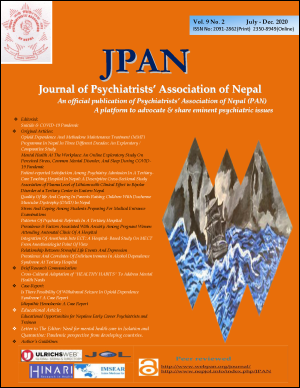Association of Plasma Level of Lithium with Clinical Effect in Bipolar Disorder at a Tertiary Center in Eastern Nepal
DOI:
https://doi.org/10.3126/jpan.v9i2.36281Keywords:
Bipolar affective disorder, Lithium, Serum concentrationAbstract
Introduction: Lithium is widely used as the gold standard for the treatment of acute and maintenance treatment of Bipolar Affective Disorder (BPAD). Its therapeutic benefits are restricted by several adverse drug reactions (ADR). Therefore, it is necessary to measure its serum concentration for optimal dosing and clinical response and to minimize toxicity. The objectives of the study were to correlate dose of Lithium with its serum concentration and serum concentration of lithium with clinical effect.
Material And Method: A cross sectional study was conducted in 213 patients presenting to psychiatric OPD, diagnosed with BPAD and taking Lithium monotherapy at least for 3 months. Data collection was done from 15th December 2018 to14th December 2019. Sociodemographic profile and relevant laboratory investigations were recorded on a self-designed proforma. Young Mania Rating Scale and Hamilton Rating Scale for Depression were applied for objective assessment of remission. Chi square test was used to correlate categorical data and ANOVA test was used for continuous data using SPSS at P-value of 0.05.
Results: Majority of patients were male (51.6%), married (62.4%), Hindu (86.9%) and in remission phase (92%). Dose of lithium was 300-1200 mg/day; serum concentration was 0.26 to 1.51mmol/L, was in therapeutic range in majority of the patients (82.6%) and was positively correlated with the dose of lithium (P-value <0.0001).
Conclusion: Lithium is very effective for maintenance therapy in BPAD with wide variation in dose and serum concentration. The dose of lithium should be guided both on the basis of clinical assessment and serum concentration.
Downloads
Downloads
Published
How to Cite
Issue
Section
License
This license enables reusers to distribute, remix, adapt, and build upon the material in any medium or format, so long as attribution is given to the creator. The license allows for commercial use.




